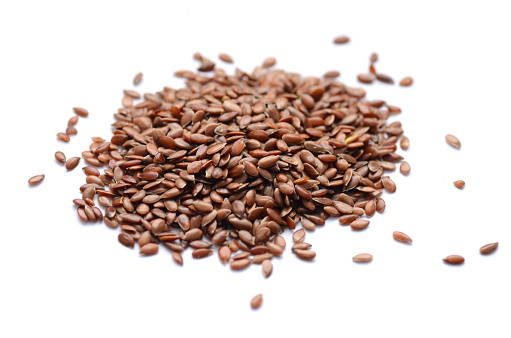Oil extraction
Flaxseed oil can be extracted in different ways.
For pharmaceutical purposes, the flaxseeds are pressed out purely mechanically in the cold pressing process (cold pressing). In this process, the ripe, crushed or whole flaxseeds, depending on the type of pressing, are de-oiled with the aid of a press. The oil yield depends on the throughput and the pressing temperature. With this type of pressing, the oil reaches a maximum temperature of 40°C. Before use, however, particles must be removed from the oil. Depending on the oil mill, this is achieved by various purification stages.
In the first instance, the oil is coarsely cleaned and then finely filtered. A safety filtration completes the purification process. All these purification stages are carried out efficiently.
As an alternative purification system, settling of the particles is used with sufficiently long storage, and subsequent decanting of the settled oil.
For technical purposes, on the other hand, hot pressing is used. For this purpose, the linseed is first preheated or heated, then pressed hot in a screw press, thus achieving the maximum degree of pressing.
The press cake can be extracted with solvents to increase the oil yield. Since linseed oil obtained in this way still contains mucilage and suspended matter, the oil is then refined.
There are two other types of linseed oil: sun thickened and blown. The former is placed in the sun for several months in a shallow tub, important for maximizing the oxidation surface, but stirring regularly to prevent film formation. In the second, an aerator is used, which also prevents film formation by constant agitation. The advantages of these two production methods are that the consistency is more viscous and the increase in volume during drying is small, (reduces the risk of wrinkling and cracking), and that the linseed oil is bleached (lighter) and the drying time is reduced. These two special grades of linseed oil are used in painting, especially Flemish Baroque painting and violin making.
Properties and shelf life
Depending on the method of production, cold-pressed linseed oil has a golden-yellow colour, while warm-pressed linseed oil is more yellowish-brown. In contrast, refined linseed oil has a light to golden yellow colour.
The smell of the oil is pyrazine-like, smells slightly toasty and spicy like hay, is described as herbaceous to dull and can have a fishy note.
Taste-wise, it is reminiscent of freshly cut grass, tasting slightly nutty and hay-like when fresh, but increasingly bitter and scratchy after storage.
Due to a high degree of atomisation, linseed oil tends to self-ignite at room temperature, but with a flash point of about 315°C and a boiling point of over 350°C it is rather difficult to ignite. The melting point is about -16 to -20°C.
Linseed oil contains more than 90% unsaturated fatty acids, with the proportion of omega-3 fatty acids, α-linolenic acid, accounting for about 45 to 71%. In addition, about 17-23.5% oleic acid and about 12-24% omega-6 linoleic acid can be found in this oil. It also has many vitamins and a relatively high content of minerals and vitamin E.
As linseed oil is very sensitive to air, it tastes bitter after a short time and quickly becomes rancid. After opening, it should be stored in a cool place. But even in the refrigerator (at about 4°C) it acquires a somewhat bitter taste after a few days and can be kept for two months at most. However, because of its low melting point, flaxseed oil can also be stored in the freezer without becoming solid. Here it can be kept for several weeks without changing its taste.
All flaxseed products should be stored in dark, airtight containers.
Use
In pharmacy and medicine
According to the “Lexikon der pflanzlichen Fette und Öle” and Markus Hartmann’s “Öle – natürlich kaltgepresst”, linseed oil has several positive properties. Due to the high content of linolenic acid in linseed oil, it has a lipid-lowering effect. In addition, this oil can lower elevated cholesterol levels and blood pressure, while also reducing sodium excretion in the urine. It also has an antibacterial effect, can strengthen the vascular system, prevent harmful deposits and prevent the formation of blood clots. Furthermore, linseed oil is used in the production of ointments, wound powder, natural soaps and thick liniment.
In industry
Linseed oil is used in technical chemistry. Here it is used as a raw material for the production of oil paints, oil varnishes, linoleum and, to a lesser extent, for the preparation of soft soaps, putty, printer’s ink and liniments. It can also be used as a paint binder, as it has a polymerising property.
Another field of application for this oil is impregnation. Linseed oil has water-repellent properties, but at the same time it is open to diffusion, which is why it is suitable for outdoor use in heavy weather conditions. It forms a waxy coating and is therefore ideal for impregnating wood, plaster, masonry and exterior facades.
Linseed oil is also used as an additive and auxiliary agent. It is used in the manufacture of linings, packaging, polishes, lubricants, wax cloths and pyrotechnic products. It is also added to latex paints to increase adhesion. In addition, epoxidised linseed oil is used as a stabiliser or as a moulding agent for vinyl-based plastics.
In the kitchen
Because of its special taste and because it is not very stable against oxidation, the use of flaxseed oil in cooking is rather low. In India, however, it is used more often for cooking and frying. Otherwise it is also found in combination with mustard, peanut or coconut oil. And in Lusatia and Silesia in particular, this oil is used in dishes containing milk, such as curd cheese with potatoes, cucumber salad or sour herring in cream sauce. The milk dishes do not become sour so quickly due to the oil layer, which is particularly practical in summer. It can also be used with vegetable dishes and raw vegetables.
In folk medicine
Due to the cell-generating effect of linseed oil, poultices with linseed oil have a softening and pain-relieving effect and thus help with painful skin cracks, burns and skin damage.
In veterinary medicine
If linseed oil is added to animal feed, it not only has a positive effect on the digestion of dogs and horses, but can also lead to a shiny coat on horses and dogs. Due to its digestive effect, it is also often used as a laxative for sheep and horses.
The remaining press cake or linseed cake after pressing is fed to livestock or spread as fertiliser.
We will be happy to advise you on this seed and show you options. Contact us
In addition to my own knowledge gained through pressing experiments, the following sources were used to prepare this article:
- Öle, natürlich kaltgepresst, Basiswissen & Rezepte, Marcus Hartmann, Hädecke, 2008
- Heilende Öle, Pflanzenöle als Nahrungs- und Heilmittel, Neue Erkenntnisse, Günter Albert Ulmer Verlag Tuningen
- Lexikon der pflanzlichen Fette und Öle, Krist, Buchbauer, Klausberger, SpringerWienNewYork, 2008
- www.wikipedia.de
- en.wikipedia.org

